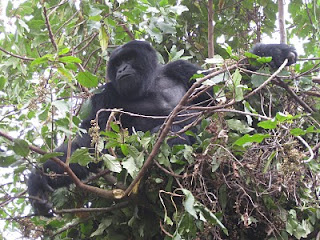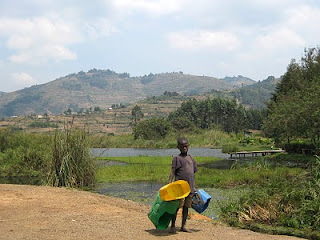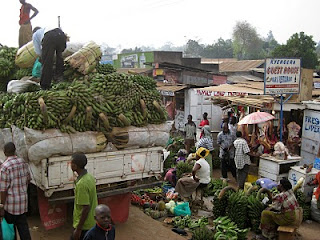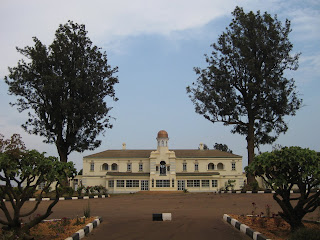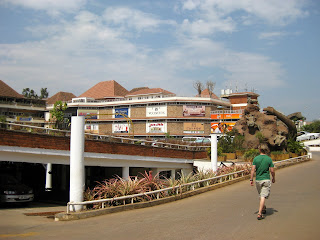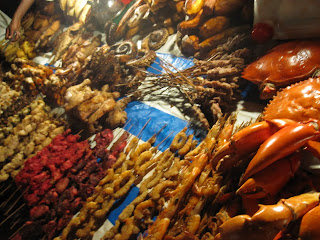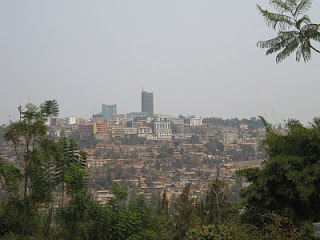 City of Kigali
City of Kigali Cafe latte at Bourbon
Cafe latte at Bourbon Rainbow by the mall!
Rainbow by the mall!I love Kigali. It is the first African city that I actually thought I could live in and be very happy. Kigali is clean, the people are extremely friendly and polite, and it is very safe. In general, Rwanda is more expensive than Uganda and Tanzania, perhaps because it is so small and has received a lot of aid?
In Kigali, we went to Bourbon, a wonderful coffee shop. I've started to love coffee, mainly because the coffee I have had in Africa has been very rich, aromatic--heavy like chocolate, but fragrant like tea. We went to some craft markets, but our main purpose was to see the genocide memorial.
The memorial is very difficult to endure, because it is so sad. I used to think that the Japanese were the most cruel and depraved fighters, since they had very sick ways of torturing and raping women. After working at the ICTR however, I am convinced that the darkest, most brutal and wretched war in human history is the Rwandan Genocide of 1994. Granted, there probably are worse wars, that I just don't know enough details about. The Interahamwe killed at a rate that was about 30 times faster than the killing of the Jews in the Holocaust. Even worse, it was a war that almost everyone participated in--civilians participated in the killing of Tutsis because the Interahamwe would kill moderate Hutus. Tutsi women and children fled to churches for protection, but the priests often collaborated with the Interahamwe, and allowed them to surround the church and slaughter everyone inside. There was widespread rape, since they would use rape to punish women. People would take bets on whether a pregant woman's baby was a boy or a girl, and then slice her womb open to see. The Japanese did stuff like that too, but I suppose what is particularly shocking about Rwanda is that many of these people lived side by side, they were neighbors--many knew each other, their children played together, but that no longer mattered. Also, the fact that civilians, often children, participated in the slaughter. Often, the interhamwe would drown people in latrines. Their way of killing was so torturous, victims would pay them money for a bullet.
There was another memorial that I did not go to. It is south of Kigali, and at this memorial, they have 800 bodies that were preserved so that they look exactly like they did right after the victims died. I did not go because I thought it would be too much to handle. You can see the expression on people's faces, and there is even a room of toddlers and babies, and you can see the machete wounds on their bodies. So, if you do want to see some of the most graphic consequences of the genocide, perhaps you should visit that memorial.
After seeing the Kigali memorial I was extemely depressed, so I went shopping at the craft market. The large craft market has a lot of traders that bring carvings from the Congo. Popular items included woven plates/baskets.
There are also many heart warming stories as well. We went to visit Hotel des Mille Collines, the hotel that inspired the movie Hotel Rwanda. It is the story of Paul Rusesabagina, a Hutu man who worked for another hotel. The European owners of Mille Collines had evacuated early on, and Paul was left to run it. During that time, he opened the hotel to Tutsi refugees, bribing the Interahamwe with money and liquor so that he could keep some people safe.
During the night, there was the opening ceremony for an annual festival called, fespad, a Pan African Dance festival. It is hosted in different countries every year, but this year it was in Rwanda. China for some reason is also in it. During the opening ceremony, they did three tirbutes t Chinese dance, which they seem to think is lots of people in bright costumes running around in circles. Of course, I was very proud that they did a tribute, and very happy. We were sitting in the free seats, having forgotten about the warning not to attended crowded events that might draw international attention. Paul Kagame gave a speech there! We got within 40 feet of him and took pictures. As we were coming down the steps however, I heard an exploding noise, and people screaming. I thought it was a bomb, but it turned out to be fireworks! I was very happy, and I was telling people that my people invented these, hahahahaha. There was lots of cheering and dancing, people would applaud when particularly large fireworks exploded.



